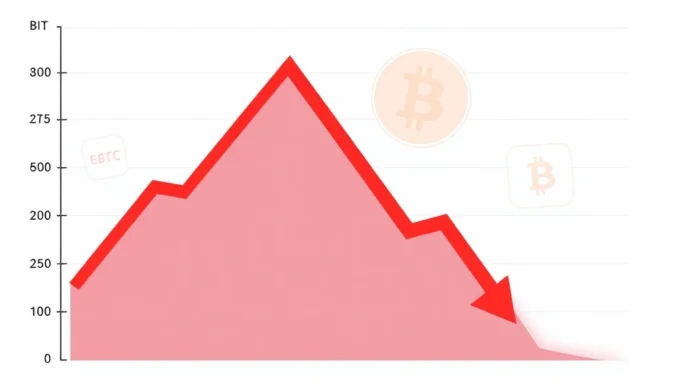
Hold onto your hats, crypto enthusiasts! March witnessed a surprising turn of events in the U.S. spot Bitcoin ETF arena. Despite the buzz and anticipation surrounding these investment vehicles, they collectively experienced a significant net outflow of funds. Let’s dive deep into the numbers and unravel what this means for the future of crypto investments.
Decoding the $745 Million Bitcoin ETF Outflows
According to insights shared by the crypto community figure Trader T on X (formerly Twitter), U.S. spot Bitcoin ETF outflows reached a staggering $745 million in March. This figure raises eyebrows, especially considering the generally positive sentiment around Bitcoin and the broader crypto market. But what exactly does this outflow signify?
Essentially, it means that for the month of March, more money was withdrawn from these ETFs than was invested. While inflows are seen as a bullish signal, outflows can sometimes indicate a shift in investor sentiment or broader market corrections. Let’s break down the performance of some key players to get a clearer picture.
BlackRock IBIT: A Beacon of Inflows Amidst the Tide
In a market narrative often painted with broad strokes, it’s crucial to examine individual performances. BlackRock’s IBIT ETF stood out as a notable exception in March. Bucking the trend of spot BTC ETF outflows, IBIT attracted a substantial inflow of $261 million.
This inflow into BlackRock’s IBIT can be interpreted in several ways:
- Investor Confidence in BlackRock: BlackRock’s reputation as a traditional financial giant might be instilling confidence in investors, even during periods of market uncertainty.
- Strategic Asset Allocation: Some investors might be strategically reallocating their crypto investments, favoring ETFs managed by established institutions like BlackRock.
- Long-term Investment Perspective: Inflows into IBIT could suggest a segment of investors is taking a long-term view on Bitcoin, leveraging ETFs for sustained exposure.

[caption]Bitcoin ETF Flow Comparison: March 2024
[/caption]
Fidelity FBTC: Experiencing Outflows in Contrast
On the other side of the spectrum, Fidelity’s FBTC ETF experienced outflows of $294 million in March. This is a significant contrast to BlackRock’s performance and contributes substantially to the overall net outflow figure.
Why might FBTC have seen outflows while IBIT saw inflows?
- Profit Taking: Investors who initially invested in FBTC might have decided to take profits, especially if they entered at lower price points.
- Market Rotation: There could be a rotation of funds within the ETF market itself, with investors shifting between different ETF offerings based on various factors like fees, perceived risk, or short-term performance.
- Broader Market Sentiment: While Bitcoin’s long-term outlook remains positive for many, short-term market fluctuations and volatility could lead some investors to temporarily reduce their exposure, reflected in crypto investment outflows.
Analyzing the Broader Crypto Investment Landscape
The net outflow from U.S. spot Bitcoin ETFs in March shouldn’t be viewed in isolation. It’s crucial to consider the broader context of the crypto investment landscape. While ETF outflows might raise concerns, they don’t necessarily signal a fundamental shift away from Bitcoin or cryptocurrencies.
Here are some points to consider:
- Market Volatility: The crypto market is known for its volatility. Periods of price correction or consolidation can trigger profit-taking or risk aversion, leading to temporary outflows from investment products like ETFs.
- Alternative Investment Options: Investors have a plethora of options within the crypto space, including holding Bitcoin directly, investing in other cryptocurrencies, or exploring DeFi (Decentralized Finance) opportunities. ETF flows are just one piece of the puzzle.
- Long-term Growth Potential: Despite short-term fluctuations, the fundamental drivers for Bitcoin’s long-term growth, such as increasing institutional adoption, store of value narrative, and potential inflation hedge, remain intact.
What Does This Mean for Your Crypto Strategy?
So, what actionable insights can we glean from these spot BTC ETF flow dynamics? It’s essential to avoid knee-jerk reactions and maintain a balanced perspective.
Here are some key takeaways for your crypto strategy:
- Don’t Panic Sell: Outflows in a single month are not necessarily indicative of a long-term trend reversal. Crypto markets are cyclical, and corrections are a normal part of the process.
- Diversify Your Portfolio: Don’t put all your eggs in one basket. Diversification across different cryptocurrencies and investment strategies can help mitigate risk.
- Stay Informed: Keep abreast of market trends, ETF flows, and broader economic indicators. Informed decisions are always better than emotional reactions.
- Consider Long-Term Perspective: If you believe in the long-term potential of Bitcoin and cryptocurrencies, short-term outflows can present buying opportunities for the patient investor.
The Road Ahead for Bitcoin ETFs and Crypto Markets
The journey of spot BTC ETFs in the U.S. is still in its early stages. March’s net outflow figure serves as a reminder that the crypto market is dynamic and subject to shifts in investor sentiment. However, the continued inflows into BlackRock’s IBIT and the overall interest in Bitcoin ETFs highlight the growing integration of cryptocurrencies into mainstream finance.
Looking ahead, several factors will likely influence the flow dynamics of Bitcoin ETFs:
- Regulatory Developments: Evolving regulations around cryptocurrencies and ETFs will play a crucial role in shaping investor confidence and market access.
- Institutional Adoption: Increased institutional adoption of Bitcoin and cryptocurrencies is expected to drive further inflows into ETFs over the long term.
- Market Maturity: As the crypto market matures, we can anticipate greater stability and potentially less pronounced volatility, which could lead to more consistent ETF flows.
Conclusion: Navigating the Crypto Tides
The $745 million net outflow from U.S. spot Bitcoin ETFs in March is a significant data point, prompting us to pause and analyze the undercurrents of the crypto market. While the headline figure might seem concerning at first glance, a deeper dive reveals a more nuanced picture. BlackRock’s IBIT demonstrated resilience, attracting inflows, while Fidelity’s FBTC experienced outflows, contributing to the overall net negative figure.
Ultimately, the crypto market is a realm of constant evolution. Understanding ETF flows, alongside broader market trends and individual ETF performances, empowers investors to navigate these tides effectively. By staying informed, maintaining a long-term perspective, and diversifying intelligently, you can position yourself to capitalize on the exciting opportunities that the crypto world continues to offer.



